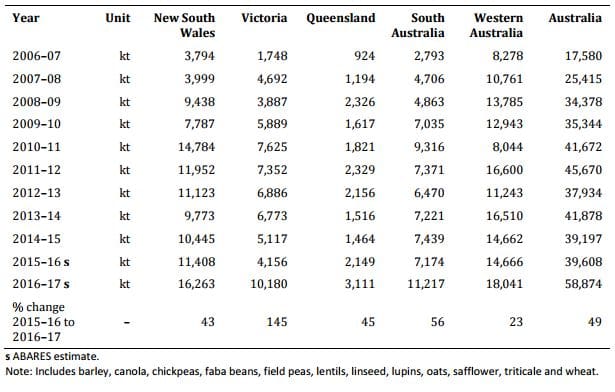AUSTRALIA’s winter crop production for the 2016/17 season hit record highs in all mainland states with an estimated 58.9 million tonnes (Mt) produced nationally, a 49 per cent increase on the previous year, according to the latest Australian crop report from ABARES.
Acting ABARES executive director, Peter Gooday, said the 58.9Mt estimate represented a 12pc upward revision on the December 2016 forecast.
“The revised winter crop estimate was the result of yields being higher than anticipated and reaching previously unseen levels in most regions,” Mr Gooday said.
For the major winter crops, wheat production is estimated to have risen by 45pc since last season to a record high of 35.1Mt, barley production by 56pc to a record high of 13.4Mt, canola production by 41pc to equal the record high of 4.1Mt achieved in 2012–13 and chickpea production by 40pc to a record high of 1.4Mt.
Harvest of the winter crop is almost finished with only small areas in Victoria yet to be taken off.
Meanwhile, drier and warmer than average seasonal conditions in the cropping regions of Queensland and northern NSW over the past three months have reduced prospects for summer crop production in 2016–17.
“The timing and quantity of rainfall over the remainder of the season will be critical to the ongoing development of dryland summer crops,” Mr Gooday said.
“That said, with summer planting now largely completed, the total area planted is estimated to have increased by 15pc in 2016–17 to around 1.4 million hectares, with total summer crop production forecast to rise by 12pc to 4.2Mt.”
Mr Gooday said the area planted to cotton was estimated to have more than doubled in 2016–17 to 557,400ha, reflecting favourable supplies of irrigation water, high levels of soil moisture early in the planting window and expected favourable returns from growing cotton.
The area planted to irrigated cotton is estimated to have increased by 66pc to 348,000ha and area planted to dryland cotton is estimated to have increased by 248pc to 209,400ha.
The increase in the share of area planted to dryland cotton is forecast to result in a 21pc fall in the average yield, and cotton production is forecast to rise by 64pc to 1.0Mt of lint and around 1.5Mt of cottonseed.
The area planted to grain sorghum is forecast to fall by 35pc in 2016–17 to 441,000ha, largely because of higher expected returns from growing cotton.
Additionally, late season planting is expected to be minimal because of unfavourable seasonal conditions over the past three months. These conditions are also expected to constrain the average yield, with production forecast to fall by 41pc to 1.2Mt.
Rice production is forecast to be around 870,000t from 250,000t in 2015–16, with the area planted estimated to be about four times higher in 2016–17 than the previous year.
Rainfall in the cropping regions of northern NSW and Queensland during the November 2016 to January 2017 period was well below average to extremely low.
In the cropping areas in southern NSW, Victoria and south-east Western Australia it was mostly average. In Western Australia and South Australia it was average to extremely high.
The February edition of the Australian crop report is available at ABARES Publications.
Source: ABARES






HAVE YOUR SAY